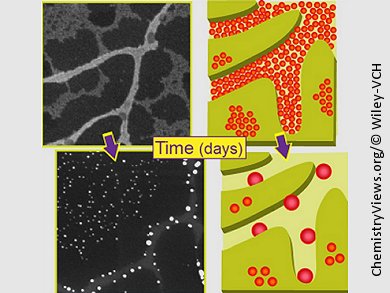When stored under ambient conditions, nanoparticles (NPs) often become unstable and merge into larger clusters. This process substantially alters properties related to the size, shape, and ordering of the NPs, and thus may be viewed as an undesired effect for many nanoparticle-based devices. However, merging of NPs into larger structures is advantageous for applications that require the formation of nanowires, for example, the fabrication of transparent conductive substrates.
Mariela Pavan and Roy Shenhar, Hebrew University of Jerusalem, Israel, have investigated dodecanethiol-capped gold nanoparticles (NPs) deposited onto a poly(ethylene glycol) substrate. They found that nanoparticles that are laid in channels of semicrystalline polymer films grow faster and to larger sizes compared with nanoparticles deposited on top of the crystalline domains, and adhere to the channel walls. It was shown that among other factors, the confinement in the channels and their low dimensionality play an important role in creating this difference.
- Effect of Channel Confinement on the Coarsening Kinetics of Nanoparticles Deposited on Semicrystalline Polymer Templates,
Mariela J. Pavan, Roy Shenhar,
ChemPlusChem 2013.
DOI: 10.1002/cplu.201300144



